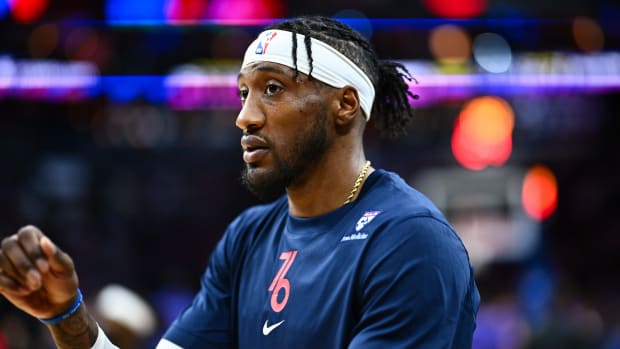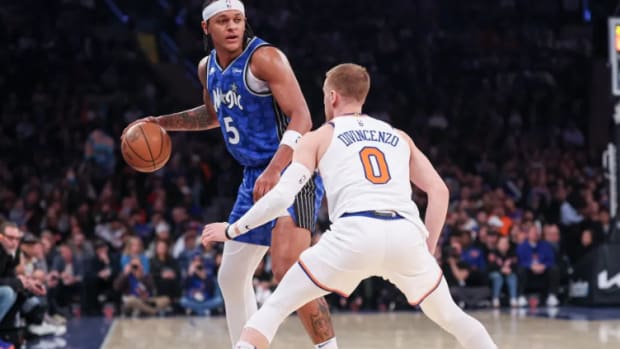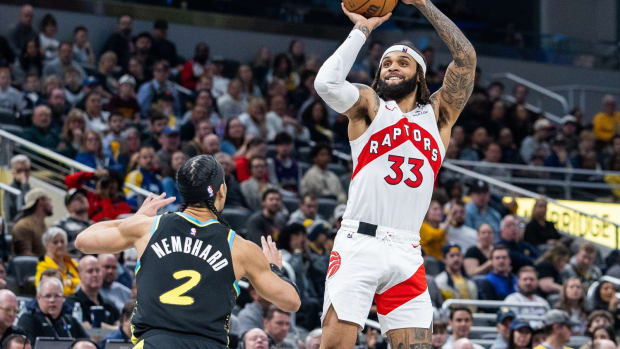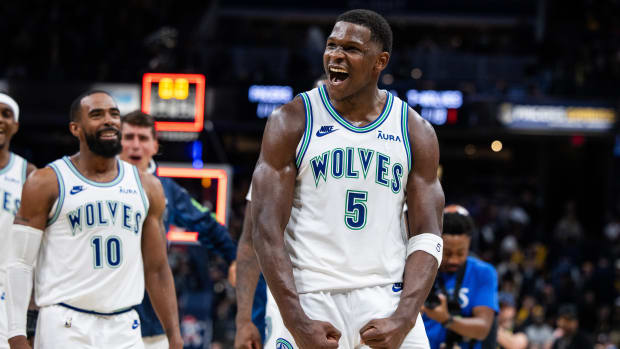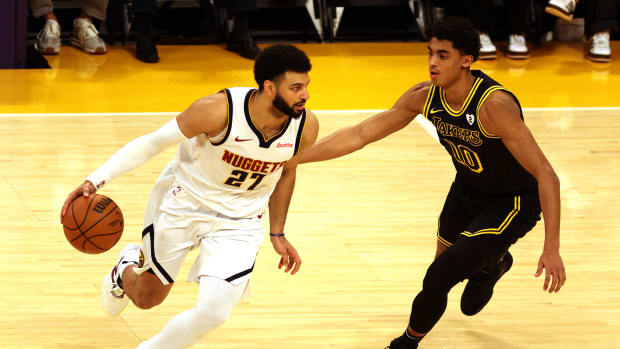Examining What a Change to the NBA's One-and-Done Rule Could Mean for All Involved
It’s been 14 years since Russ Granik, the NBA deputy commissioner at the time, announced that the Detroit Pistons had selected Amir Johnson of Westchester High School with the 56th pick in the 2005 NBA Draft.
Johnson, who is now in his 14th NBA season, became the last “prep-to-pro” player selected in an NBA draft. He had spent no time attending college nor did he play professionally in the minors or abroad. Instead, Johnson went directly from high school to the NBA. He was the 40th player between 1975 and 2005, an era when the NBA welcomed players straight out of high school, to do so. And he was the last.
The following year, the NBA would implement a controversial age eligibility rule. The rule had been negotiated by the NBA and NBPA and detailed in Article X of their 2005 collective bargaining agreement. Article X dictated that in order for an American player to be draft eligible, he must be at least 19 years old and at least one NBA season must have elapsed since when he graduated from high school or, if he didn’t graduate, when he would have graduated.
The era of “one-and-done” thus began in 2006. Most players who would otherwise have joined the NBA out of high school instead attended college for a year—or, more accurately, took fall semester courses and then dropped out of school when their team’s season ended sometime between February and April. In a few instances, players such as Brandon Jennings, Jeremy Tyler and Emmanuel Mudiay skipped college and played professionally abroad until becoming eligible for the NBA draft.
The one-and-done era continues to this day, though it might soon end. As first reported by USA Today’s Jeff Zillgitt, the league has proposed to the NBPA that the eligibility rule be changed by the 2022 NBA Draft. The change would restore the legal right of 18-year-old players to declare for the NBA draft out of high school.
Given this moment, it’s worth taking stock of why the NBA has evolved in its views on the relationship between age, eligibility and the law.
Understanding why the NBA raised the age limit
In the mid-2000s, advocates of raising the NBA age limit believed the change would improve the league’s quality of play. Superior shooting, passing and rebounding would presumably attract more fans and consumer dollars, and thus enhance the league’s business interests.
This plan was not intended to benefit owners exclusively. Players already in the league possessed a stake in seeing the NBA generate more revenue, even if it meant foreclosing opportunities for younger players. Players and owners share “basketball-related income” (BRI), a collectively bargained term that includes revenue generated by apparel contracts, as well as revenue generated by NBA broadcasts, arena signage and other properties. At the most basic level, players make more money when the league makes more money: higher BRI means a higher salary cap and higher salaries. It is thus in the financial interests of players to see the league offer a more marketable product.
Whether or not the heightened eligibility has played an influential role, NBA revenues have climbed considerably over the last 15 years. In 2005, league annual revenue totaled approximately $3 billion. Nowadays that figure exceeds $8 billion. Driving this revenue surge is the dramatic increase in league television revenue. The willingness of TV networks to pay more to broadcast NBA games reflects, at least in part, an assessment that NBA games are attracting more viewers. For players, the increase in total revenue has led to higher BRI and thus higher salaries.
Elevation of the age limit was expected to make the league more dynamic and polished. To that point, advocates stressed that players who enter the NBA at 19 instead of 18 are more physically mature and have an extra year of experience. Most also compete in elite DI programs or play professionally abroad for that one year. This means that they develop against talented competition—and at no cost to the NBA or to NBA owners.
Likewise, even some of the better “prep-to-pro” players tended to struggle or play sparingly in their rookie seasons. As a rookie, future legend Kobe Bryant shot 41.7% from the field while averaging 7.6 points, 1.9 rebounds and 1.3 assists in 15.5 minutes per game. Similarly, rookie (and future All-Star) Rashard Lewis averaged 2.6 points per game on 36.5% shooting. If those players had entered the NBA a year later, they presumably would have been more refined and more ready-to-play.
Players who joined the NBA after a year of college ball are also easier to market to prospective season ticket holders. When the Denver Nuggets selected Syracuse freshman Carmelo Anthony with the third pick in the 2003 NBA Draft, Nuggets and NBA fans already knew a great deal about him. They had watched Anthony play on TV and seen him dominate. Anthony had led the Orange to a national championship and he was named the NCAA tournament’s Most Outstanding Player. 20 picks later in that same draft, the Portland Trailblazers selected Travis Outlaw. To many fans, Outlaw was an enigmatic figure, having played ball at Starkville High School in Mississippi. While Outlaw had been a terrific high school player (and went on to play 11 seasons in the NBA), his relative obscurity at the time made it challenging for the Trail Blazers to excite their fans about him.
Scouts for NBA teams also sometimes bemoaned having to stake their professional reputations on projecting how well high school players would succeed in the NBA. Prep-to-pro players often starred against decidedly inferior competition. They would accumulate “video game-like” statistics that were not particularly meaningful in the context of NBA scouting. For example, Al Jefferson, whom the Boston Celtics drafted with the 15th overall pick in 2004 NBA Draft, averaged 43 points, 18 rebounds and seven blocks per game during his senior season at Prentiss High School in Mississippi. Though Jefferson, who currently plays for the Xinjiang Flying Tigers of the Chinese Basketball Association, would go on to have a successful 14-year NBA career, his high school dominance did not translate into NBA-readiness. Jefferson played sparingly in his rookie season. While Jefferson’s role grew in his second NBA season, it was not until his third season—when he averaged 16 points and 11 rebounds per game—that the Celtics’ investment in this young player pay off.
There were also famous—or infamous—draft mistakes involving prep-to-pro players. In 2001, the Washington Wizards selected Glynn Academy’s Kwame Brown with the first overall pick. Brown never lived up to the billing and is widely considered a “bust.” That label isn’t completely fair. Brown played 12 seasons in the NBA. Over time, he would become a serviceable big man. Had Brown been drafted later in the first round, he would not be remembered as a bust. Still, NBA teams would have likely more effectively scouted Brown and more accurately predicted his future if he had played a year in college.
Robert Swift is a better example of a prep-to-pro lottery pick who failed. After being drafted by the Seattle Supersonics with the 12th overall pick in the 2004 draft, Swift played in only 97 games over four seasons. He also battled a drug problem. Making matters worse, after Swift’s brief NBA career ended, he amassed an arrest record that included attempted armed home invasion.
NBA owners also disliked investing millions of dollars in 18-year-old players who would require years of development before they could be relied upon for meaningful roles. Free agency rights only complicated that dynamic. Owners could invest considerable time and money into developing prep-to-players only to see them leave as free agents after a few seasons. Consider Jermaine O’Neal, who played sparingly for the Portland Trail Blazers in his first four seasons while he was 18 to 21 years. The Trailblazers then traded O’Neal to the Indiana Pacers, where he would build on what he had learned in Portland and blossom into a perennial all-star. The Trail Blazers, in other words, never really saw a return on their investment in O’Neal. In recognition of that point, owners pushed for other entities—be they college basketball programs or pro teams in Europe and Asia—to develop young talent instead.
Lastly, there was an element of paternalism in the drive to raise the age limit. In 2001, NBA commissioner David Stern toldThe New York Times, “If these kids have the ability to get a little more maturity, a little more coaching, a little bit more life experience overall, that's good.” Along those lines, commentators were quick to point out players who had attempted the jump from high school and failed to catch on. Taj McDavid often received attention as an example of why players should go to college. McDavid, who played at Palmetto High School, went undrafted in 1996. Under NCAA rules at the time, McDavid lost his eligibility to play D-I basketball. He then lived in a mobile home with his parents. McDavid became something of a scarecrow reference to other young players who were thinking about declaring.
Marty Blake, the NBA’s director of scouting, would tell SI’s Alexander Wolff in 1997 that McDavid’s plight was a “tragedy”: "That wasn't a story. That was a tragedy. The NBA gets unjustified criticism for all this, because it can't prevent anyone from coming out. But these kids need the money. They don't like school. And they think they're ready."
In hindsight, it’s not clear that McDavid failing to attract the interest of NBA teams was so tragic. D-I programs weren’t interested in him, either. McDavid had played in the equivalent of Division 3 high school basketball and hadn’t attracted athletic scholarships from any major college. His declaration for the NBA draft, in other words, gave up something that he wasn’t going to get anyway. McDavid also went on to other ventures and became a productive citizen. As Jeff Pearlman described in a Bleacher Report story, McDavid attended college, gained training as a paralegal and worked at a law firm.
Understanding why raising the age limit has attracted criticism
It’s rational that NBA teams would prefer that young players develop on someone else’s dime. It’s also rational that young players would object to being shut out of the NBA.
For starters, a bright-line, inflexible ban on players out of high school belies the success of so many players who made the jump. Many of the prep-to-pro players became long-time NBA players. In some cases, they became stars or even Hall of Famers. Moreover, because prep-to-pro players began their NBA careers early on, they gained access to NBA free agency at an earlier point and thus could amass considerable earnings over an elongated career arc.
Consider that three of the NBA’s greatest 50 players of all-time skipped college (and, unlike ABA and NBA legend Moses Malone, none of the three played in a different pro league between high school and the NBA):
(NBA seasons + total NBA contracts)
- LeBron James (16 seasons, $237.0 million)
- Kevin Garnett (21 seasons, $343.9 million)
- Kobe Bryant (20 seasons, $328.3 million)
Many others became NBA all-stars:
- Jermaine O’Neal (18 seasons, $168.8 million)
- Tracy McGrady (15 seasons, $163.0 million)
- Rashard Lewis (16 seasons, $155.3 million)
- Tyson Chandler (18 seasons, $173.5 million)
- Amar'e Stoudemire (14 seasons, $167.7 million)
- Dwight Howard (15 seasons, $213.8 million)
- Andrew Bynum (9 seasons, $72.9 million)
And still others went on to become longtime NBA players, playing at least seven seasons:
- Al Jefferson (14 seasons, $133.0 million)
- Josh Smith (13 seasons, $111.8 million)
- Lou Williams (14 seasons, $58.2 million)
- Monta Ellis (12 seasons, $96.6 million)
- Stephen Jackson (14 seasons, $68.6 million)
- Al Harrington (16 seasons, $90.3 million)
- J.R. Smith (15 seasons, $72.1 million)
- Amir Johnson (14 seasons, $77.0 million)
- Darius Miles (7 seasons, $62.0 million)
- Eddy Curry (11 seasons, $70.1 million)
- DeSagana Diop (12 seasons, $47.0 million)
- DeShawn Stevenson (13 seasons, $27.9 million)
- Travis Outlaw (11 seasons, $44.9 million)
- Kendrick Perkins (14 seasons, $57.3 million)
- Shaun Livingston (13 seasons, $49.5 million)
- Sebastian Telfair (10 seasons, $19.0 million)
- Dorrell Wright (11 seasons, $28.7 million)
- Martell Webster (8 seasons, $46.5 million)
- Gerald Green (11 seasons, $19.6 million)
- C.J. Miles (13 seasons, $42.2 million)
- Jonathan Bender (8 seasons, $30.6 million)
- Andray Blatche (9 seasons, $39.7 million)
This is not to say that all of those players were stars or even comparatively “good.” Some were bench players and others bounced around different teams. Still, by any sensible objective metric, to play at least seven seasons in the NBA and amass tens of millions of dollars in earnings while there ought to be viewed as a successful career run.
At the same time, some prep-to-pro players were busts. Their impatience and ill-preparedness to enter the NBA likely harmed their careers. Take Lenny Cooke, who declared for the 2002 NBA Draft. Despite at one point being the No. 1 ranked high school player in the country (ahead of LeBron James and Carmelo Anthony), Cooke wasn’t drafted. Although Cooke played for the Boston Celtics’ summer league team in 2003, the Celtics didn’t sign him. He went on to play in the minor leagues and abroad. Cooke later became the subject of an award-winning documentary film, Lenny Cooke.
Of course, one could easily identify “busts” who played one year, two years, three years or four years of college ball. This is even true of players who were drafted first overall. The Cleveland Cavaliers and Philadelphia 76ers each had a year of college tapes to review when deciding whether to use their first overall picks on Anthony Bennett and Markelle Fultz, respectively. Or take the Los Angeles Clippers, who studied three years of Michael Olowokandi’s game tapes at Pacific and decided to draft him first overall in the 1998 NBA Draft. Similarly, there are plenty of highly-acclaimed international players who tried and failed in NBA (see Darko Miličić, the second overall pick in the 2003 NBA Draft). The NBA draft is an inexact science regardless of the age and experience of draft-eligible players.
Some critics of Article X have also highlighted that a rule requiring that players, regardless of their talents, wait a period of time after high school before becoming eligible is unusually restrictive. No such rule exists for the NHL, MLB, MLS the UFC, pro tennis or pro golf. In most sports, young athletes turning pro is not unusual. Take 13-year-old American soccer phenom Olivia Moultrie. She just turned pro on Monday and has signed a multi-year endorsement contract with Nike. Dallas Mavericks star Luka Dončić may be an NBA rookie, but he signed his first contract with a pro basketball team (Real Madrid) at age 13. Similarly, recording artists and actors can ply their trade long before high school starts, let alone a year after it ends. To the extent one supports economic freedom, Article X undermines it.
This discrepancy between one when can turn pro is also vexing when factoring in race. The only three major pro leagues that require players wait a period of time after high school before becoming eligible are also the only three African-American majority leagues (the NBA, WNBA and NFL). While these leagues’ eligibility rules aren’t designed to treat African-American athletes differently, those rules disproportionately impact African-American athletes.
Members of Congress have noticed. In 2009. Congressmen Steve Cohen described the NBA’s age limit as a “vestige of slavery.” He demanded that the NBA and NBPA change the rule, while telling Pete Thamel (then of The New York Times), “There’s something wrong with keeping kids, who are more likely to be African-American than not, from playing professional basketball and football when they can help their families and communities immediately.”
Lastly, the risk of injury during college is another reason used to justify players being able to jump from high school to the NBA. The most recent reminder of this risk occurred when Duke freshman star Zion Williamson, who projects to be selected first overall in the 2019 NBA Draft, suffered a knee injury after his sneaker broke. Although Williamson is expected to fully recover, the incident highlighted the substantial financial risk faced by elite players while in college. Williamson could potentially earn tens or hundreds of millions of dollars in the NBA, yet he is reportedly insured for only $8 million.
The risk of pre-NBA injury has had more lasting consequences for other players. Randy Livingston, a journeyman NBA point guard in the late 90s and early 2000s, might have become a dominant NBA player if not for a devastating knee injury. In the early 90s, Livingston was the nation’s number one recruit out of Newman High School in Louisiana. He had won the Naismith Award in 1992 as the nation’s top high school player. Shortly before attending LSU, however, he tore his right anterior cruciate ligament and was never the same player. Young stars obviously want to avoid suffering injuries at any point. However, if an injury occurs, it is better for the player that it happens while he is playing on an NBA contract with a salary guarantee than as an unpaid amateur.
The legality of the NBA’s age restriction
It might strike you as counterintuitive that the NBA and the NBPA—a union that represents NBA players, not future NBA players—could bargain away the eligibility of players not yet in the NBA.
As explained above, NBA owners have rational financial interests in seeing young players develop at the expense of others, whether they be colleges or pro teams in other leagues. NBA players also have a stake in seeing young stars not enter the league. Upon entering the NBA, those players will take jobs away from current players who are members of the union. This dynamic arguably presents a conflict of interest that adversely affects teenage basketball stars. It also reflects an agreement among competing businesses (that is, NBA teams) to not compete for certain players.
Despite the potential conflict and its anti-competitive quality, the NBA’s eligibility restriction is protected by court precedent. In Maurice Clarett v. NFL, the U.S. Court of Appeals for Second Circuit ruled that the NFL and the NFLPA could collectively bargain an eligibility restriction that prevents players from draft eligibility until three years have passed from when the graduated or would have graduated high school. I served on the legal team that represented Clarett in 2004. Clarett’s lead counsel, Alan Milstein, argued that the rule should not be insulated from legal scrutiny merely due to collective bargaining.
To that end, Milstein stressed that the NFL’s eligibility rule primarily relates to persons who, because of it, can’t become NFL players, draftees or NFLPA members. An eligibility rule is thus different from a rookie wage scale since the wage scale clearly impacts NFL players. In contrast, an eligibility rule governs persons who it prevents from becoming NFL players. Judge (and now U.S. Supreme Court Justice) Sonia Sotomayor disagreed, reasoning that young players’ eligibility would impact wages and working conditions of current players since those current players would need to compete with them. This impact was sufficient from Judge Sotomayor’s perspective to allow the NFL and NFLPA to agree on a rule that bars the eligibility of even the most talented players who are, in some cases, two years out of high school.
Despite the Clarett decision, there remains the possibility that a player precluded by the NBA, WNBA or NFL eligible rule could challenge it in court. The Clarett decision is not “national precedent.” The decision is precedent in one federal circuit, the Second Circuit. In truth, the Second Circuit is the most significant circuit for sports leagues given that it governs New York, where the NBA, WNBA, NFL, MLB and NHL—as well as most of their respective players’ associations—are all headquartered. Also, any of those leagues would seek to transfer litigation filed in other circuits back to the Second Circuit on grounds it would be a more appropriate venue.
Still, a player could attempt to rely on more favorable precedent by suing in other circuits. Three of those circuits, the Eighth Circuit (which includes Missouri, Iowa, Arkansas and Minnesota), the Sixth Circuit (which includes Ohio, Michigan, Tennessee and Kentucky) and the D.C. Circuit, appear to follow the precedent of John Mackey v. NFL. In that case, the Eighth Circuit held that agreements by leagues and unions are only exempt from antitrust scrutiny when a restraint on competition—such as an age restriction—(1) primarily affects parties to the related collective bargaining agreement; (2) reflects wages, hours, and other employment terms; and (3) emerged from bona fide arms-length bargaining. A player shut out by the NBA’s eligibility rule argue that rule primarily affects those not yet in the league and thus those who are not parties to collective bargaining. Also, because of Article X, players out of high school are denied any and all wages, hours and employment in the NBA. While this argument might work in theory, it has not been tried in court.
One might also question whether the NBA’s eligibility rule constitutes unlawful age discrimination. From the perspective of federal law, the answer is no. The federal Age Discrimination in Employment Act of 1967 protects persons who are 40 and older from age discrimination in the workplace. It does not protect younger persons who are denied employment because of their age.
From the perspective of state law, the answer is maybe. Lou Pechman, a New York labor and employment attorney, has argued that the rule violates New York State Human Rights Law, which forbids employers from refusing to hire a person who is 18 years or older on account of his or her age. No player has brought a lawsuit to challenge the NBA’s eligibility rule on the basis of age discrimination.
How increasing problems for the NCAA and the rise of the G League alter the NBA’s calculus
Since the age eligibility rule was raised in 2006, the NBA has paid close attention to what might be described as “market failures” in college basketball. Ever since former UCLA star Ed O’Bannon successfully sued the NCAA over its agreement with Electronic Arts to put college basketball players in video games and other products without their consent and without paying them, college athletes have become more aware of the controversial system of “amateurism.” A number of them have also sought to change it.
Under amateurism, the maximum that NCAA players can receive from their schools is the “grant-in-aid,” which includes tuition, fees, room, board, course-related books and other expenses up to the value of the full cost of attendance. Players, even uber-marketable ones like Zion Williamson, are forbidden from signing endorsement deals or otherwise capitalizing on the use of their name, image and likeness. Meanwhile, coaches, athletic directors, network executives and numerous other figures in college sports can profit considerably from college hoops. To illustrate: while the desire to watch Williamson play has led to dramatically higher ticket prices for Duke games, Williamson can’t receive any of that value under NCAA rules. However, his coach, Mike Krzyzewski, is reportedly paid $9 million a year. Amateurism in college sports is, in reality, making the athlete the amateur, while those around him or her can be pros.
In addition to the O’Bannon case, football players at Northwestern University sought to be recognized as employees under the National Labor Relations Act. Although the effort proved unsuccessful in 2015 for jurisdictional reasons, it could be attempted again by players at other schools. In addition, we await a decision from U.S. District Judge Claudia Wilken on the grant-in-aid litigation. A group of players have argued that colleges agreeing to cap grant-in-aid levels constitutes a violation of antitrust law. The argument is based on the idea that colleges are competing businesses and that they have conspired, through NCAA rules, to refrain from competing beyond the grant-in-aid.
The NBA has also seen the criminal justice system attempt to curb illegal payments and other corruption in college basketball. Last October, jurors in New York convicted three defendants, including Adidas director of global marketing James Gatto, of wire fraud and conspiracy to commit wire fraud charges. Other defendants have reached plea deals or are awaiting trial. The NBA has likely reasoned that the long-term growth of players might be enhanced if they sidestep the more corruptive qualities of college basketball and simply join the NBA (or G League) right out of high school. In the NBA, players are paid “over the table” in transparent and lawful ways.
The NBA’s desire to lower the age limit also comports with the NCAA’s own recommendations. In April 2018, an NCAA college basketball commission led by former U.S. Secretary of State Condoleezza Rice recommended, among other things, that the “one-and-done” rule be eliminated. “These uniquely talented elite players are the focus of agents, apparel companies, investment advisors, college coaches and others seeking to profit from their skills,” Rice noted. “If these players are allowed to turn professional, some of the pressure on the collegiate model will be reduced.”
The NBA’s own innovation is also a driving force behind its desire to lower the age limit. Beginning in the 2019-20 season, the G League will offer elite prospects who are at least 18 years old but yet ineligible for the NBA draft “select contracts.” These contracts will pay players $125,000, plus provide health care and other employment benefits, for the five-month G League season. Players who sign select contracts will also receive training on financial literacy and post-career planning. Since they will become professionals, these players will be able to sign endorsement deals. Furthermore, G League players, like NBA players, can always begin, resume or finish college, at least on a part-time basis, and focus on academics since they are ineligible to play under NCAA rules.
An enhanced G League that competes with the NCAA will only mean better opportunities for young players. It will also provide scouting and developmental value to the NBA and its teams. NBA scouts would normally rather evaluate players who are exposed to professional style offenses and defenses. If NBA teams had a chance to evaluate Fultz playing in the G League, where players are more skilled, older and larger than in college, rather than watching him play for the University of Washington against Pac-12 competition, perhaps they would have learned more about him and his draft prospects would have been more appropriate. In addition, players in the G League are coached by NBA coaches whose interests are aligned with NBA teams rather than those of universities.
To be sure, some elite 18-year-old players will pick playing in college basketball for a year rather than going to the G League. A player on Duke, for instance, is probably better able to build his brand and marketability given the national attention that is paid to Blue Devils basketball. If that same player were on the Maine Red Claws or the Fort Wayne Mad Ants, he would not be on games nationally broadcast by ESPN during primetime hours. Still, competition between the G League and college hoops is a good thing.
Next steps
Article X won’t change in time to alter the 2019 NBA Draft and perhaps not the 2020 or 2021 NBA Drafts, either. The current CBA runs through the 2023-24 season (with a mutual opt-out clause after the 2022-23 season). Although CBAs can be amended before they expire, unions and management typically wait until the next round of bargaining to make major changes. This reflects the idea that CBAs consist of trade-offs of workplace policies relating to wages, hours and other working conditions.
That said, the NBPA seems inclined to support the move. In 2015, NBPA executive director Michele Roberts opposed a possible plan to raise the age limit to 20 years old. She has also offered critical comments about the age limit being 19 years old instead of 18. The NBPA, however, may want to know if a proposal to change the age limit would be connected to other changes, such as greater access to draft-eligible players’ medical records.
Still, indications are that the age limit will be lowered at some point within the next few years.
Milstein, for one, is pleased that his efforts in court 15 years ago may be translated into action.
“This is the way the free market is supposed to operate,” Milstein tells SI. “Athletes should be treated no differently than musicians, or actors, or software savants. If they can sell their services at a young age, and their parents are in accord, the market should allow it.”
Milstein suggests the NBA and NBPA should learn from Moultrie. “This young soccer phenom can always go to college but she should be able to exercise her passion at the highest level if she is worthy.”
This same principle used to apply to 18-year-old basketball phenoms. We’ll soon see if the future restores that past.
Michael McCann is SI’s legal analyst. He is also Associate Dean of the University of New Hampshire School of Law. In 2004, McCann authored “Illegal Defense: The Irrational Economics of Banning High School Players from the NBA Draft.”






























